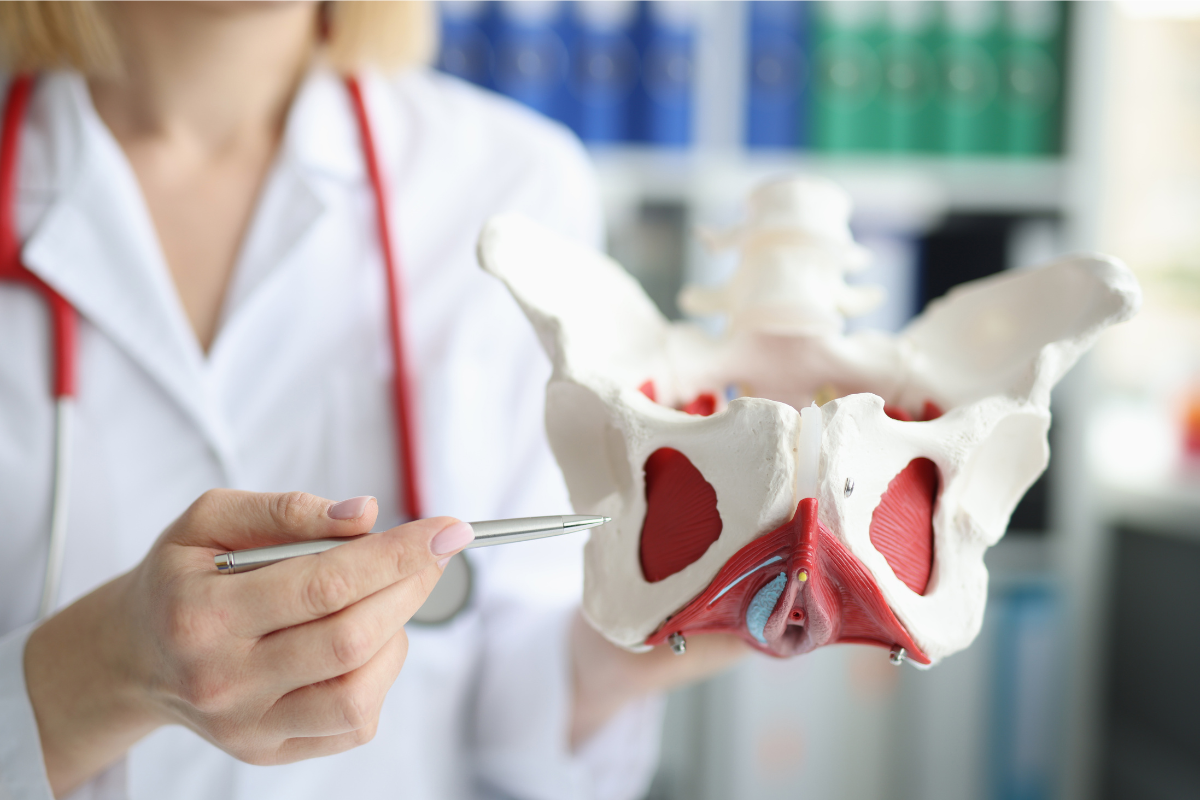Menopause & Your Pelvic Floor

Despite the fact that the majority of women will experience bowel, bladder or sexual concerns at some point in their lives, many people say that talking about these symptoms feels embarrassing.
We think that taking a deep breath and starting the conversation is an important first step. You’re less alone than you think—and there’s probably a treatment strategy or two available to help you.
If you don’t already know about the pelvic floor’s anatomy and function, start first by checking out the article What Is the Pelvic Floor?
What Are Pelvic Floor-Related Symptoms?
In short, these symptoms affect your bowel, bladder or sexual functioning. While some are caused directly by issues with the pelvic floor muscles, most are multifactorial and influenced by our biology, habits, diet and lifestyle.
Bladder symptoms
- Urinary leaking
- Urinary urgency and frequency
- Incomplete emptying or difficulty starting urine flow
Bowel symptoms
- Leaking gas or stool
- Constipation (infrequent and/or hard stools)
Pain symptoms
- Pain with external touch around the vagina or anus
- Pain with penetration and/or deeper movement
- Aching in the pelvis with activity or certain positions
Pelvic support symptoms
- Sensation of “falling out” and heaviness in the vagina and/or rectum
- Visible bulge of tissue at the vaginal opening
The Influence of Menopause on the Pelvic Floor
Estrogen affects every body system, including the tissues in the pelvis by:
- Encouraging collagen production in the vulvar and vaginal tissues, keeping them thick and strong
- Promoting blood flow and pH levels in the vagina that reduce risk of UTIs and vaginal infections
As women move through perimenopause into menopause, estrogen levels decline, and these processes are disrupted. While it’s clear that pelvic organs and tissues are responsive to estrogen, and many people begin to experience symptoms around menopause, research has been unable to tease apart the effect of menopause versus aging in general.
Low estrogen leads to less collagen production, which can then lead to vaginal and vulvar tissues that are thinner, less flexible and have less natural lubrication or cervical discharge. All of these changes can add up to sexual pain and difficulties.
Pelvic organ prolapse can also develop or worsen around menopause since low estrogen can reduce the resilience and support of the pelvic organ connective tissues. Prolapse is when the pelvic organs (bladder, uterus and/or rectum) lose some degree of connective tissue support and descend towards the vaginal opening.
Prolapse does not always cause symptoms, but the vast majority of women will be able to see some degree of anatomical changes by postmenopause. If you begin to experience sensations of vaginal or rectal heaviness or bulging around the menopause transition, it may be a sign of pelvic organ prolapse.
The lack of estrogen around menopause may also impact the support of the urethra and detrusor muscle, leading to urinary leakage, frequency and urgency of the bladder.
The one undeniable influence of declining estrogen is the near-universal experience of vaginal dryness after menopause. While women experience differing severities of dryness and discomfort, it is nearly guaranteed that you will notice some change. Many women with prolapse symptoms say that they feel much more comfortable when they treat their vaginal dryness.
For more specifics about menopause-related vaginal dryness, check out this article.
Other Causes of Pelvic Floor Symptoms
Factors beyond hormonal changes can also contribute to midlife pelvic floor symptoms. Important factors that influence your risk for pelvic floor symptoms in midlife include:
Pregnancy and birth history
- Your number of pregnancies, cesarean and/or vaginal births can be a major influence on pelvic floor function. Those with a history of multiple vaginal deliveries, especially involving significant injury to the pelvic structures, are at higher risk of pelvic floor symptoms throughout their lives.
Body size
- Having a larger body size increases pressure on the pelvic floor
Chronic constipation
- Frequent, hard straining can affect pelvic muscle and connective tissue over time
Pelvic surgery
- Surgery may have altered or removed pelvic structures or injured muscles or nerves
Genetics
- Do any of your first degree female relatives also have pelvic floor-related issues?
Changes related simply to aging (versus menopause) are also critical to consider.
Activity levels
- Are you moving as much as you used to? Statistics show that people exercise less as they age. If you’re moving your body less, your pelvic floor is also getting less exercise.
Muscle mass
- Without strength training, people naturally lose muscle mass with age in a process that accelerates around age 50. The muscles in and around the pelvis are affected by this process as well.
Dietary habits
- What and when we drink and eat has a lot to do with bladder and bowel function. You may be feeling pelvic floor-related symptoms due more to shifts in your food and drink intake than anything related to your muscles.
What Now?
Topical or oral estrogen therapies have been shown to be effective in treating symptoms like vaginal dryness, frequent infections and urinary urgency. Your healthcare provider can help you better understand your symptoms and determine if these options are right for you.
Pelvic floor physical therapy is another great option for treating many of these symptoms. Pelvic PTs are trained in evaluating the pelvic floor muscles and other contributing factors, and helping you understand how to use exercise and other techniques to address your concerns.
Finally, Midday offers a range of resources about pelvic floor concerns that may guide you in managing your own symptoms.
If you aren’t having symptoms, staying strong and active is one of the best steps you can take to keep it that way.
Sign up for more unique women’s health content
By submitting this form, you agree to the Lisa Health Privacy Policy and Terms of Use


